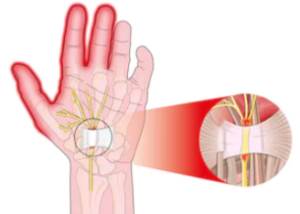
After carpel tunnel syndrome surgery, it’s possible to experience lingering or residual pain that might shoot up the entire arm and affect the shoulder.
Remember, the carpal tunnel compression has caused irritation to the median nerve, which runs the length of the arm (beginning from hand) all the way up to the shoulder and neck where it comes out from the spinal cord.
Pain from carpal tunnel syndrome doesn’t always disappear 100 percent immediately after surgery.
The median nerve may still be irritated, and this can cause pain or discomfort even several days after carpal tunnel surgery, including pain in the shoulder. My mother had carpal tunnel surgery on both hands at the same time.
She was experiencing pain from carpal tunnel in the shoulder before surgery, and post-surgery for several days, and sometimes it ran down the length of the arm.
Based on my experience working with my mother; plus my experience as a certified personal trainer working with clients who had various body tweaks; and my own experience with sports injuries over the years, I had my mother do some specific exercises to relieve the post-surgical carpal tunnel pain.
The surgeon told her that this post-surgical carpal tunnel shoulder pain was “par for the course” and that it would eventually disappear.
However, in the meantime, it’s not pretty. A person with this problem will typically intuitively remain immobile and ride the pain out, perhaps taking “pain pills,” namely, whatever their surgeon prescribed for them for post-surgical carpal tunnel pain.
The combo of narcotics and inertia didn’t work for my mother, and quite frankly, I don’t see how they can work for anybody’s post-surgical carpal tunnel pain.
The drugs caused other undesirable side effects, and inertia “unteaches” the body to be efficient at movement.
Stand with feet shoulder width apart.
Raise both arms straight up, as though to shake someone’s hand. Keep them nearly straight. Raise them parallel to floor.
If this hurts, raise to just below the threshold of pain. If you can go past parallel, do so. Lower. Repeat for total of 12 times.
Continuing to stand, keep both arms straight at sides, palms facing body.
Rotate palms outward so that they’re facing forward, then rotate them so that they’re facing behind you.
This action will open and close the shoulder joint as well as rotate entire arm. Repeat both directions 12 times.
Bend over, one hand resting on countertop or table for support.
Let other arm dangle. Rotate shoulder in circles, forward 12 times, then backwards 12 times, letting arm hang relaxed. Don’t bend arm. Repeat other side.
Place two coins on kitchen countertop about a foot apart.
Place hands before either coin. Now, cross forearms over each other so that opposite hands are now aligned with each coin. Return to start position. Repeat 12 times.
Standing, move arms as they would as if running in slow motion.
Exaggerate the arm movement so that shoulders get a good rotary and vertical workout. Do this for 30-60 seconds.
By this point, the shoulder pain should be mostly dissipated. If it isn’t, then perhaps you can design some different exercises.
I also recommend follow-up visits with the doctor who performed the carpal tunnel surgery.
Inertia in absence of structured exercise isn’t the answer; it will only further stiffen up the joint and reduce blood circulation.
 Lorra Garrick has been covering medical, fitness and cybersecurity topics for many years, having written thousands of articles for print magazines and websites, including as a ghostwriter. She’s also a former ACE-certified personal trainer.
Lorra Garrick has been covering medical, fitness and cybersecurity topics for many years, having written thousands of articles for print magazines and websites, including as a ghostwriter. She’s also a former ACE-certified personal trainer.
.









































